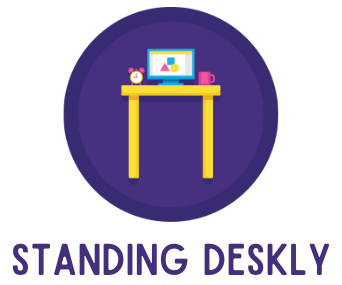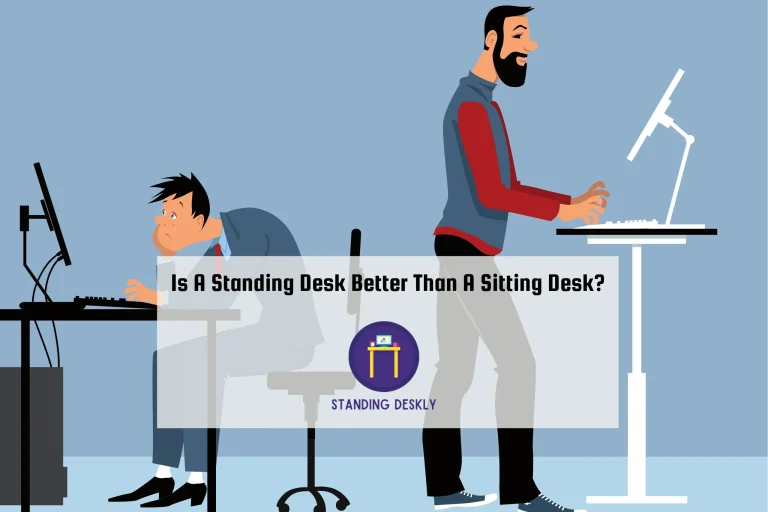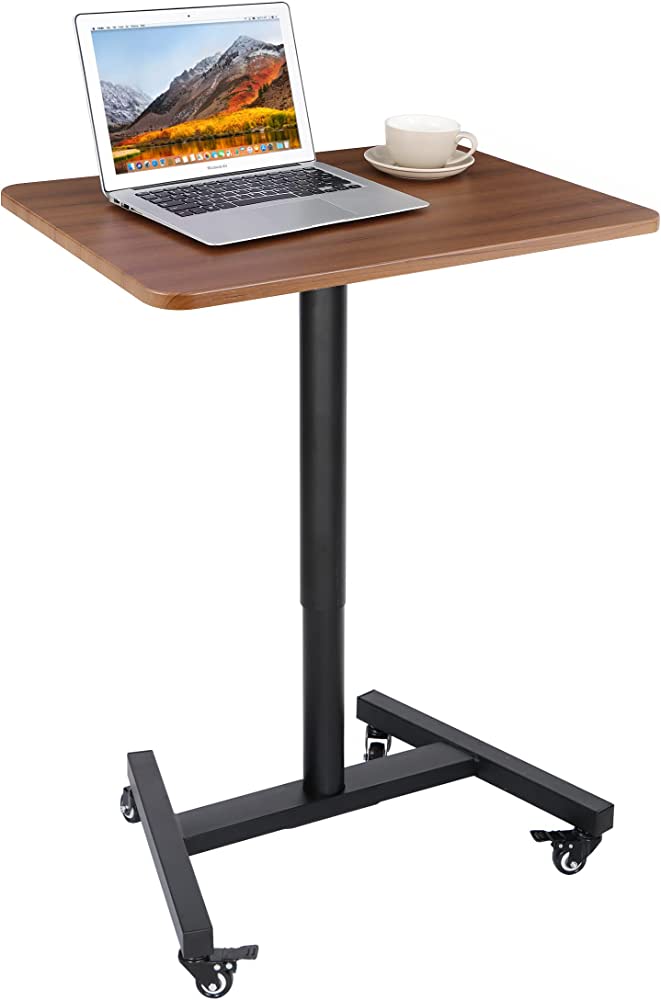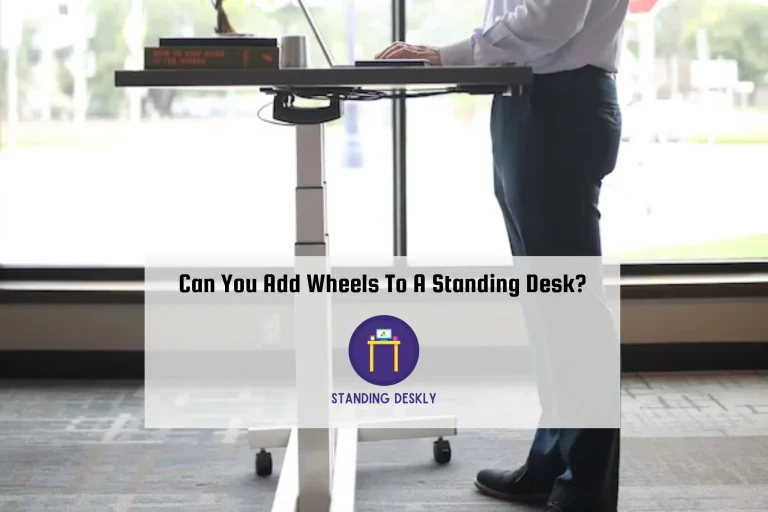Revolutionize Your Work Life: Standing Desks for Arthritis Relief
Standing desks can significantly reduce arthritis pain and discomfort. Regular use of standing desks helps to improve posture, increase circulation, and decrease joint stiffness for people with arthritis.
Arthritis is a chronic condition marked by inflammation in the joints, which is responsible for pain and stiffness experienced by the patient. It affects millions of people globally, making it a major public health issue. For patients with arthritis, finding a comfortable position to work can be a daunting task.
However, standing desks have emerged as an effective option for managing arthritis symptoms in the workplace. Regular use of standing desks helps to increase movement, improve posture, reduce stiffness and pain, and boost energy levels which helps maintain their quality of life. This article aims to explore the benefits of standing desks for people with arthritis in detail.

Credit: www.vela.eu
Understanding Arthritis
Standing desks have exploded in popularity in recent years. Reasons including stress relief and improved posture. For people with arthritis, standing desks provide a range of additional benefits. So let’s dive into the benefits of standing desks for people with arthritis.
Specifically, this section will focus on different types of arthritis that impact workplace productivity and the prevalence of arthritis in the us workforce. Let’s go!
Different Types Of Arthritis That Impact Workplace Productivity
Arthritis is an inflammation of the joint. It results in pain, swelling, and stiffness. But not all arthritis is created equal. There are over 100 types of arthritis, but for this article’s purposes, we’ll focus on two common types that impact workplace productivity:
- Osteoarthritis: This occurs when the joints’ cartilage (the rubber-like padding that covers the ends of bones and provides cushioning) wears down over time. It commonly occurs in knees, hips, and joints in the hands.
- Rheumatoid arthritis: This is an autoimmune disease that occurs when the immune system mistakenly attacks the joint lining, resulting in inflammation. It commonly occurs in wrists, fingers, and toes.
The Prevalence Of Arthritis In The Us Workforce
Did you know that arthritis is the leading cause of disability in the united states? And according to the centers for disease control and prevention (cdc), one in four working-age adults has arthritis. This means that millions of americans are living with arthritis, and many of them are trying to navigate the challenges of working with arthritis.
Symptoms And Effects On Work Productivity
Arthritis can impact work productivity in a variety of ways. Here are some common symptoms and effects:
- Pain: Arthritis pain can make it challenging to focus, concentrate, and complete tasks. For example, typing can be challenging for those with arthritis in their hands.
- Fatigue: People with arthritis may experience fatigue, which can make it difficult to get work done efficiently.
- Reduced mobility: Arthritis can cause joint stiffness, making it hard to get up from a seated position or move around the office.
- Reduced flexibility: Reduced flexibility can make it challenging to bend down to pick up objects or reach for things.
- Missed workdays: Severe pain and fatigue can cause missed workdays. According to the cdc, adults with arthritis are more likely to have work limitations and miss workdays than those without arthritis.
Standing desks can alleviate some of the symptoms of arthritis. Research has found that standing desks can improve posture, reduce back pain, and boost energy levels. These benefits translate into improved work productivity, allowing people with arthritis to do their jobs more comfortably and efficiently.
Standing desks are an excellent solution for people with arthritis. They provide an array of benefits that can improve work productivity, comfort, and overall well-being. Make sure to consult with a healthcare professional before switching to a standing desk and take breaks regularly.
Traditional Work Desks And Their Negative Impact
Standing desks are a great alternative to traditional work desks, and they have several health benefits, especially for people with arthritis. Sitting for extended periods can put pressure on the joints and lead to a more painful experience.
Discuss Problems Associated With Traditional Work Desks
Traditional work desks pose several issues that can cause pain and discomfort for people with arthritis. Here are some of the problems associated with traditional work desks:
- Hunched posture which can lead to back, shoulder and neck pain
- Insufficient legroom which puts increased pressure on the joints
- Sitting for long periods leads to reduced blood flow and muscle weaknesses
Effect On Knee, Back And Hip Joints
Sitting for long periods could have negative impacts on knee, back, and hip joints for people with arthritis. People with arthritis may experience joint pain and stiffness. Here are some of the effects of traditional work desks on knee, back, and hip joints:
- Back pain caused by poor posture and insufficient back support
- Knee pain caused by prolonged sitting and reduced blood flow to the knees
- Hip pain caused by increased pressure on the hip joints from sitting for long periods.
The Implication Of Prolonged Sitting
Sitting for long periods can have negative effects on overall health, leading to more health complications and discomfort. Here are some of the implications of prolonged sitting:
- Increased risk of obesity and weight gain
- Increased risk of heart disease and stroke due to insufficient blood flow
- Increased risk of developing diabetes
- Increased risk of depression and anxiety
Standing desks are a great alternative to traditional work desks for people with arthritis. Traditional work desks can cause pain in knees, back, and hip joints, and prolonged sitting could lead to several complications that can cause discomfort. By switching to standing desks, people with arthritis can enjoy several benefits that lead to better health.
Benefits Of Using A Standing Desk For Arthritis Relief
Highlight The Advantages Of Using A Standing Desk
Sitting for extended periods has become an increasingly common phenomenon in the modern world, resulting in a rise in numerous health problems, including arthritis. But, introducing a standing desk in your workspace can have numerous advantages for people dealing with arthritis.
Some of the significant benefits of using a standing desk for arthritis relief are:
- Encourages better posture and reduces the pressure on your joints and spine.
- Improves blood circulation, making sure that the nutrients are effectively distributed throughout your body.
- Enhances the efficiency of your digestive system and helps in burning calories.
- Enhances your mood, levels of concentration, and focus, promoting overall productivity.
Discuss Results From Recent Studies On Sitting Vs Standing
Several studies advocate for the use of standing desks rather than sitting desks to reduce the risk of arthritis, back pain, and inflammation. In reality, studies have shown that sitting for prolonged periods is hazardous to your health. For instance, a study published in the american journal of preventative medicine noted that prolonged sitting could lead to multiple health issues, including –
- Spinal disc damage
- Cancer
- Heart disease
- Obesity
- Diabetes
Furthermore, standing reduces the stiffness, joint pain, and inflammation associated with arthritis. A study published in the journal of physical activity and health indicated that participants who used standing desks experienced significantly fewer back pains and less muscle soreness than those who used sitting desks.
Discuss How Standing Desks Can Be Used To Prevent Arthritis-Related Problems
The best way to prevent arthritis is by making changes that reduce the risk factors. You should aim to adjust and personalize your workstation setup to minimize the discomfort and fatigue associated with prolonged sitting. Here’s how a standing desk can help with preventing arthritis-related complaints –
- Standing while working can reduce the pressure on the joints, which may decrease the risk of developing arthritis.
- Standing desks can encourage better posture, which can reduce the risk of back and neck strain.
- A standing desk may help you burn more calories and keep your weight under control, reducing the stress on your joints.
- Standing also helps fight inflammation, which can exacerbate the symptoms of arthritis in the joints.
Investing in a standing desk can offer you long-term benefits associated with your health, productivity, and overall lifestyle. Utilize the benefits of quality ergonomics by incorporating a standing desk into your workspace to reduce the risk of arthritis and other health problems related to prolonged sitting.
Types Of Standing Desks For Arthritis Relief
Standing desks have become increasingly popular as people become more aware of the effects of prolonged sitting on our health. People with arthritis often struggle with traditional seated workstations, making standing desks a more comfortable and efficient solution. These desks are designed to accommodate a range of heights, making them ideal for people with arthritis.
Introduce The Different Types Of Standing Desks Available
There are several types of standing desks available on the market that cater to different needs. Here are some of the most popular options:
- Fixed standing desks: These desks don’t have any height adjustment features and are designed for people who prefer a fixed height. They are simpler and more affordable than other types of standing desks.
- Manual standing desks: These desks have a hand crank or a lever that allows you to change the height of the desk. They are ideal for people who want more flexibility but don’t want to invest in an electric desk.
- Electric standing desks: These desks are powered by an electric motor, which makes it easy to adjust the height with the push of a button. They are ideal for people who switch between sitting and standing regularly.
- Convertible standing desks: These desks are designed to convert from a traditional seated desk to a standing desk. They can be added to an existing desk, making them an affordable option.
Discuss Which Standing Desks Are Ideal For Arthritis Relief
People with arthritis often struggle to sit in one position for an extended period, which makes standing desks great options for arthritis sufferers. The best standing desks for arthritis relief are electric standing desks and convertible standing desks that offer the following features:
- Height adjustability: The desk should have a range of height adjustability to accommodate a variety of sitting and standing positions.
- Stable base: The base of the desk should be stable and sturdy, to avoid any wobbling which can cause discomfort or instability whilst typing.
- Ergonomic design: The desk should be designed to support the natural curve of the spine, which can help reduce pressure on joints and alleviate pain.
Discuss The Components Of An Adjustable Standing Desk
Adjustable standing desks have several components that work together to provide a comfortable and ergonomic workspace. Here are some of the components of an adjustable standing desk:
- Desktop: The desktop is the working surface of the desk and should be able to support all of your work items comfortably.
- Height adjustment mechanism: This mechanism can be manual or electric, and it allows you to adjust the height of the desk to your specific needs.
- Base: The base of the desk is the foundation that supports the desktop. It should be stable, sturdy, and able to support the weight of the desktop and all of your work items.
- Cable management: This system ensures all cables are kept neatly and securely underneath the desk. If there are visible cables on the floor, it can cause additional tripping hazard which can be dangerous for people with arthritis.
- Monitor arms: These can mount your screen at the correct height and distance to reduce neck and eye strain.
All types of standing desks designed to help alleviate arthritis can be beneficial to those who suffer from inflammation or joint pain, but incorporating the right components into the desk can make the workstation even more effective. Electric adjustable desks and convertible standing desks are the most practical options for people who need a level of flexibility but don’t want to compromise on stability and adjustability.
By investing in ergonomically designed furniture, you can create a comfortable, healthy workspace for yourself and lessen the negative effects of prolonged sitting.
How To Choose The Right Standing Desk For Arthritis Relief
Standing desks have gained popularity in recent years due to their health benefits. People who suffer from arthritis can benefit greatly from using standing desks as they can help reduce pain and discomfort caused by prolonged sitting. However, choosing the right standing desk for arthritis relief can be a daunting task.
In this section, we will discuss the factors to consider when choosing an adjustable desk, the price range, features to look for that relieve arthritis pain, and warranties and guarantees that you should consider.
Discuss Factors To Consider When Choosing An Adjustable Desk
Before purchasing an adjustable desk, there are several factors to consider to ensure it meets your specific needs. Here are some key points to consider:
- Height adjustment: Ensure the desk can be adjusted to the correct height, allowing you to stand without hunching or reaching upward.
- Weight capacity: Check the weight capacity of the desk to ensure it accommodates your computer, monitor, and other accessories.
- Desk shape and size: Ensure the desk is spacious enough to accommodate your work setup, such as a monitor, keyboard, and mouse, among others.
- Stability: Stability is crucial, and you should opt for a desk with a sturdy frame that doesn’t wobble or tip over.
- Ease of use: The desk should be simple to adjust, and the height adjustment mechanism should be smooth and easy to control.
Price Range
Standing desks are available at different price points, ranging from a few hundred dollars to several thousand dollars. An adjustable standing desk is a large investment, and you should consider your budget before making a purchase. Here are the price ranges you could consider:
- Entry-level standing desk (under $500)
- Mid-range standing desk (between $500 and $1000)
- High-end standing desk (above $1000)
Features To Look For That Relieve Arthritis Pain
Nowadays, adjustable standing desks come with unique features to improve the user’s experience and help relieve arthritis pain. Here are some key features to consider when choosing a standing desk that can relieve arthritis pain:
- Memory settings: A standing desk that can remember your preferred height settings will allow you to switch from sitting to standing without having to adjust the desk each time.
- Anti-fatigue mat: These mats can provide you with comfort and reduce foot fatigue.
- Tilting keyboard: A keyboard tray that tilts can help promote a more natural posture, alleviating pressure on your shoulders, neck, and back.
- Armrests: Armrests can help support your arms and reduce strain on your shoulders.
Discuss Warranties And Guarantees
When investing in an adjustable standing desk, you want to be sure that you’re making a wise investment. Here are some warranties and guarantees to consider:
- Manufacturer’s warranty: Check the manufacturer’s warranty to see what is covered and for how long.
- Return policy: It’s essential to check the return policy before making a purchase in case you are not satisfied with the desk.
- Reviews: Check online reviews from other customers to see how reliable and durable the desk is.
When choosing a standing desk, it’s essential to consider the factors mentioned above, such as height adjustment, weight capacity, ease of use, stability, size and shape, price, features, warranties, and guarantees. A quality standing desk will improve your posture, reduce the risk of chronic diseases, and alleviate arthritis pain, making it an excellent investment in your health.
How To Use A Standing Desk For Arthritis Relief
Standing desks have become increasingly popular in recent years, and for a good reason. Not only do they offer numerous health benefits, but they are also an excellent way to alleviate the pain associated with arthritis. However, simply standing for an extended period is not enough to relieve arthritis pain.
You need to learn the proper way to use a standing desk for it to be effective. Here is how to use a standing desk for arthritis relief.
The Proper Way To Use A Standing Desk
Standing desks come in several shapes and sizes, but the basic principles of using them remain the same. Here are some key points to keep in mind when using a standing desk for arthritis relief:
- Begin by standing with your feet shoulder-width apart.
- Keep your shoulders relaxed and your arms at your sides.
- Ensure that your elbows are bent at a 90-degree angle and your wrists are straight.
- Place your monitor at eye level, about an arm’s length away from you.
- Adjust your keyboard so that your elbows are at a 90-degree angle, and your wrists are straight.
- Use an anti-fatigue mat to reduce the pressure on your feet.
Formulate A Plan To Incorporate Standing Desk Into Your Work Routine
Using a standing desk regularly is an excellent way to reduce arthritis pain and improve your overall health. However, it is crucial to ease into using a standing desk and not overdo it. Here is how you can incorporate a standing desk into your work routine:
- Begin by standing for short periods, say 15-20 minutes, and gradually increase the duration.
- Mix up your sitting and standing time with some walking around or stretching.
- Take frequent breaks to rest your feet, knees and hips.
- Listen to your body, and if you experience any discomfort, sit down to rest.
- Try to stand up for at least 2 hours a day and increase it gradually, if possible.
Discuss Necessary Equipment For Optimal Posture
Using a standing desk is only beneficial if you use it correctly. To achieve optimal posture, you need to consider some necessary equipment. Here are some things to keep in mind:
- Invest in an adjustable standing desk that can be raised or lowered to your desired height.
- Use a sturdy and comfortable chair to take breaks whenever you need to sit down.
- Use a footrest or anti-fatigue mat to reduce the pressure on your feet.
- Use a monitor arm that allows you to move your screen to eye level and adjust it for ergonomics.
- Use an ergonomic mouse and a keyboard to reduce wrist and shoulder pain.
Using a standing desk can be a game-changer if you have arthritis. However, your success depends on how well you use it. Remember to start slowly and build up the duration gradually. Mix it up with some stretching and take frequent breaks.
Ensure that your posture is correct and invest in necessary equipment to make your standing desk experience more comfortable. Incorporating these tips can change the way you work for the better, and you may never switch back to a traditional desk again.
Additional Steps Towards A More Ergonomic Workspace
Benefits of standing desks for people with arthritis: additional steps towards a more ergonomic workspace
For people with arthritis, a standing desk can be a game-changer in reducing pain and discomfort. However, solely adopting a standing desk isn’t enough to create an ergonomic workspace. Here are some additional steps to take to create a space that promotes healthy joints and eliminates unnecessary strain.
Alternate Ergonomic Accessories
Using ergonomic accessories can help create a healthier workspace. Here are some options to consider:
- Ergonomic keyboard and mouse: These accessories can reduce hand and wrist pain by allowing your arms to rest in a more natural position.
- Footrest: A footrest can help alleviate pressure on your feet and legs, making standing for longer periods more comfortable.
- Monitor stand: Proper height alignment of your monitor is important to prevent neck strain. A monitor stand can help you adjust the height and angle of your monitor quickly.
Exercises That Reduce Joint Stiffness In The Workplace
Incorporating stretching and movement throughout your workday can help reduce stiffness and promote flexibility. Here are some exercises you can do:
- Shoulder rolls: Circle your shoulders forwards and backwards to release tension in your neck and shoulder muscles.
- Desk push-ups: Place your hands on your desk shoulder-width apart, and push yourself away from the desk while keeping your back straight.
- Sit-to-stand: Alternate sitting and standing every 30 minutes to promote blood flow and reduce stiffness in your joints.
Ergonomic Office Chairs
Sitting for extended periods can cause discomfort and pain for people with arthritis. As such, upgrading to an ergonomic office chair can help create a more comfortable workspace. Here are some features to look for:
- Adjustability: Look for a chair that allows for seat height, depth, and backrest adjustments.
- Lumbar support: A chair with good lumbar support can alleviate lower back pain by supporting the natural curvature of your spine.
- Wheelbase: Opt for a chair with a five-wheelbase to provide stability and mobility.
By incorporating these additional steps, you can create an ergonomic workspace that supports your health and wellbeing when using a standing desk. Remember to frequently stretch, move, and incorporate other ergonomic accessories and features to get the most out of your workspace.
How To Build Your Own Standing Desk
Standing desks have been gaining popularity over the years, and for people with arthritis, it could be beneficial. Arthritis is a condition where joints get inflamed or swollen, causing stiffness, pain, and difficulty in moving. By standing up during work, you could reduce inflammation and stiffness in the joints, thus allowing for increased mobility and comfort.
Building your own standing desk is a great solution to give you the flexibility to work both standing and sitting.
Discuss Diy Options For An Affordable Standing Desk
Standing desks vary in price, but some options can be costly. Building your own standing desk can be more cost-effective while allowing you to customize it according to your needs.
Here are some diy options to consider:
- Standing desk converter: If you already have a desk, you can convert it into a standing desk by adding a converter. It’s a great cost-effective option and easily adjustable to accommodate your sitting needs.
- Adjustable desk: You can make an adjustable desk by using hydraulic or electric legs or manually adjustable legs. It’s important to measure the proper height to allow you to work comfortably and maintain proper posture.
- Wall-mounted desk: If you have limited space, consider building a wall-mounted desk. It’s a great space-saving option and can be easily assembled using a wooden plank.
Give A List Of All Materials Required
Materials depend on the type of desk you want to build. Here is a list of materials you may need:
- Standing desk converter: Converters come with all the necessary materials; it is just a matter of finding one that fits your desk.
- Adjustable desk: Hydraulic legs, electric legs, or manually adjustable legs, tabletop, screws, drill, wood glue, measuring tape, and level.
- Wall-mounted desk: Wooden plank, brackets, screws, measuring tape, level, stud finder, and drill.
Provide A Step-By-Step Guide, Which Is Simple To Understand.
Building your own standing desk requires some tools, time, and effort, but it can be an enjoyable experience. Here are the steps to building your own desk.
Standing Desk Converter
- Purchase a standing desk converter that fits your existing desk size.
- Adjust the height to your liking.
- Place your computer and other peripherals on the converter.
- Enjoy your new standing desk!
Adjustable Desk
- Choose the right tabletop material, size, and design.
- Decide on the type of legs you want: Hydraulic, electric, or manually adjustable legs.
- Attach legs to the tabletop using screws and wood glue.
- Use a measuring tape and level to make sure both sides are equal height.
- Enjoy your new adjustable desk!
Wall-Mounted Desk
- Find a sturdy wooden plank that’s long and wide enough to fit your work equipment.
- Mount your brackets on the wall using a stud finder, measuring tape, and level.
- Secure the wooden plank to the brackets with screws.
- Test the weight capacity and adjust as needed.
- Enjoy your new wall-mounted desk!
Building your own standing desk gives you the flexibility to work comfortably while reducing joint pain and stiffness caused by arthritis. Whether you choose a standing desk converter, adjustable desk, or wall-mounted desk, follow the steps above to create a desk specifically catered to your needs.
Frequently Asked Questions On Benefits Of Standing Desks For People With Arthritis
What Are Standing Desks?
Standing desks are desks that are designed for use while standing rather than sitting. They allow people to work on tasks while standing up and offer a range of health benefits.
How Do Standing Desks Help Arthritis?
Standing desks help arthritis by allowing people to stand while they work, which can relieve strain on the joints and reduce inflammation. They also promote better posture and circulation.
Can Standing Desks Help With Arthritis Pain?
Yes, standing desks can help with arthritis pain by reducing pressure on joints, improving posture, and promoting circulation. They are especially helpful for people with osteoarthritis and rheumatoid arthritis.
What Are The Benefits Of Standing Desks For People With Arthritis?
The benefits of standing desks for people with arthritis include reduced joint pain and inflammation, improved posture and circulation, and enhanced overall health and wellbeing.
How Do I Choose The Right Standing Desk For My Arthritis?
When choosing a standing desk for arthritis, look for one that is adjustable, stable, and comfortable to use for extended periods. Consider the ease of use and the features that are most important to you.
Conclusion
With all the evidence presented, it is clear that standing desks are a game-changer for people with arthritis. By utilizing a standing desk, arthritis sufferers can reduce their pain levels, increase their energy levels, improve their posture and overall health, and even burn some extra calories throughout the day.
The benefits of standing desks are numerous, and incorporating them into your daily routine can significantly improve your quality of life. Whether you are working from home or in an office, there is a standing desk option that can fit your needs.
So, if you are looking for a way to alleviate your arthritis symptoms and take the first steps toward a healthier lifestyle, you might want to consider giving standing desks a try. It is a small investment with a big payoff, so what are you waiting for?
Start enjoying the benefits of standing desks today!

I’m the author and developer of Standingdeskly, the go-to site for standing desk enthusiasts. I provide comprehensive reviews of standing desks along with office setup tips. Combining years of research and personal experience, our goal is to make it easy for you to find the perfect standing desk tailored to your needs.






